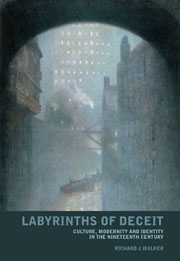Book contents
- Frontmatter
- Contents
- Acknowledgements
- Introduction: Tracing the fragments of modernity
- Part I (De)Generating doubles: duality and the split personality in the prose writing of James Hogg, Robert Louis Stevenson and Oscar Wilde
- Part II The stripping of the halo: religion and identity in the poetry of Alfred Tennyson, James ‘B. V.’ Thomson and Gerard Manley Hopkins
- Part III Infected ecstasy: addiction and modernity in the work of Thomas De Quincey, Alfred Tennyson, Christina Rossetti and Bram Stoker
- Conclusion: Ghost-script
- Notes
- Bibliography
- Index
Introduction: Tracing the fragments of modernity
- Frontmatter
- Contents
- Acknowledgements
- Introduction: Tracing the fragments of modernity
- Part I (De)Generating doubles: duality and the split personality in the prose writing of James Hogg, Robert Louis Stevenson and Oscar Wilde
- Part II The stripping of the halo: religion and identity in the poetry of Alfred Tennyson, James ‘B. V.’ Thomson and Gerard Manley Hopkins
- Part III Infected ecstasy: addiction and modernity in the work of Thomas De Quincey, Alfred Tennyson, Christina Rossetti and Bram Stoker
- Conclusion: Ghost-script
- Notes
- Bibliography
- Index
Summary
All Truth is change.
All that is solid melts into air.
this strange disease of modern life,
With its sick hurry, its divided aims.
What is it like to be in a state of crisis? To be more specific what is it like to be in a state of crisis in the nineteenth century? The aim of this book is to explore such a condition and to ask, as a significant subclause: what is it like to be modern in the nineteenth century? This interaction between crisis and modernity is not a randomly chosen connection. Isobel Armstrong, in her radical rethinking of the political and subversive elements of Victorian poetry, states that ‘Victorian modernism, as it emerges in its poetics, describes itself as belonging to a condition of crisis which has emerged directly from economic and cultural change.’
Armstrong's positioning of Victorian culture, in particular its poetics, in direct correlation with a cultural and socio-economic topography effectively conflates the two questions posited above; nineteenth-century modernity as it appears in cultural representation is intrinsically equated with crisis. In Armstrong's definition modernism in terms of poetics doesn't get engendered by crisis or act as a response to it, it is explicitly affiliated with it; the definition therefore identifies a significant act of belonging – to engage with the strategies and devices of Victorian modernism is to be in crisis.
- Type
- Chapter
- Information
- Labyrinths of DeceitCulture, Modernity and Identity in the Nineteenth Century, pp. 1 - 26Publisher: Liverpool University PressPrint publication year: 2008



